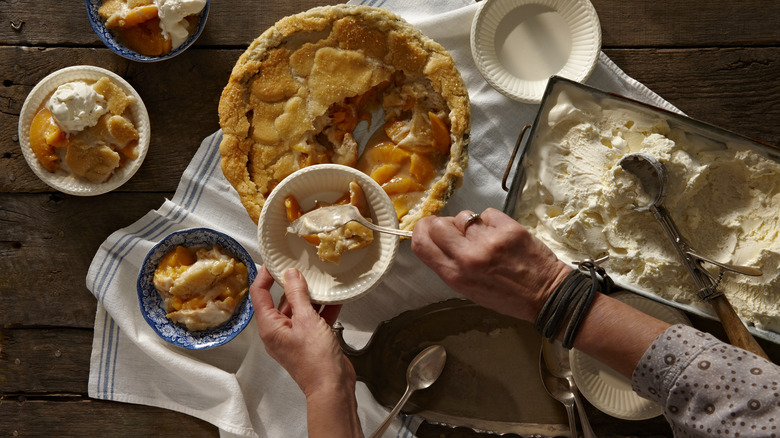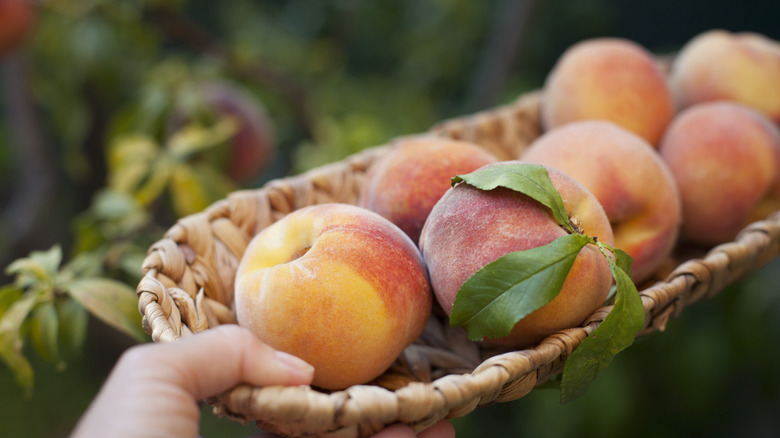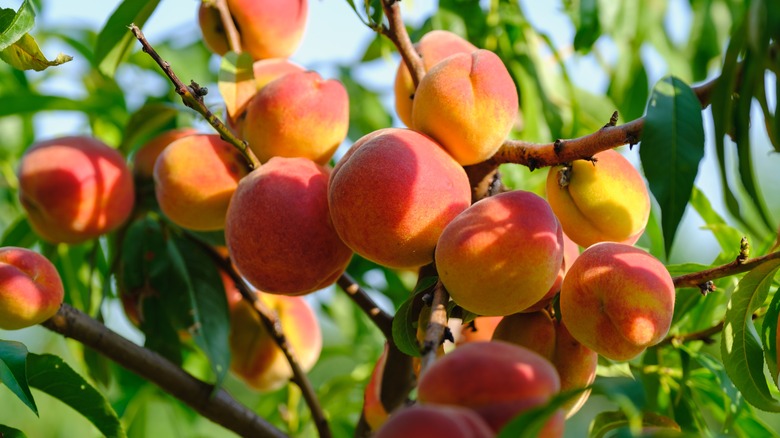The Reason Peach Pie Was Made The Official State Dessert Of Delaware
Every August 24th, peach pie lovers all over the country have an excuse to nosh on peach pie until they need to loosen their belt. That auspicious date is National Peach Pie Day, a holiday dedicated to the consumption of the fruity dessert. The exception, of course, is for the people of Delaware. They have no need for such an excuse. Since 2009, peach pie has been the state's official dessert, so every day is Peach Pie Day in Delaware, whether anyone else in the country sees fit to celebrate it or not. We should all be so lucky.
Leave it to a kid, or a bunch of kids as the case may be, to suggest that the sweet, gooey pie be given "official" status in the first place. On July 30, 2009, the 145th Delaware State Assembly took the advice of the fifth and sixth grade students at St. John's Lutheran School in Dover and formally made peach pie the state's dessert. All of this came in recognition of the important role that peaches have played in Delaware's history since the Colonial Era.
It seemed only fitting, then, that peach pie be crowned the official dessert of Delaware. That this designation could also benefit tourism and the economy is an added bonus for residents of the Diamond State.
The history of peaches in Delaware
In reality, declaring peach pie the official state dessert probably wasn't a hard-sell. By the time that government officials had declared that the peach blossom should become the state's flower in 1895, the peach tree had already entrenched itself in Delaware's soils and economy. Wild peach trees have grown in the state for centuries. However, records of them dating back to the 1700s suggest that people didn't think that peaches were worth eating, let alone par-cooking for the perfect pie filling. Rather, peaches became fodder for pigs during that era. (A pig's gotta eat and all.)
Fortunately for peach pie lovers everywhere, farmers in Delaware started growing peach orchards by 1832, moving the fruit one step closer to being the star of pies than it had been in the century or so prior. The orchards sprung up first in Kent County, thanks to Isaac Reeves, who used a grafting technique to create uniformity among peach types.
Over the decades that followed, peach farmers in Sussex County joined their counterparts in Kent County. Their efforts were helped along by the proliferation of the railroad, which made it possible for farmers to deliver six million baskets of peaches to market in 1875. By 1895, Delaware enjoyed the distinction of being the U.S. state that produced the most peaches in the world, although it's since been unseated.
The challenges to the state's peach tree growth
But it wasn't all peachy for Delaware farmers. In the 1890s, a disease called "peach yellows" raged through peach orchards in the state, taking the peach crop from an estimated four million trees down to 300,000 in the span of 60 years or so. As we know now, aphids caused the disease's rampant spread. For a long time, though, farmers didn't know how to fight against peach yellows. Out of desperation, they cultivated different crops, including apple trees.
The remnants of those early peach varieties remain, though the fruits coming out of Delaware today are much smaller than their ancestors. Two cities, Middletown and Wyoming, keep the memory of the peach's past in Delaware alive by hosting festivals each August to remember the role that the fruit has played in the state's history. And given that at least one of those festivals features a peach pie contest, it's unlikely that the good people of Delaware will forget why the dessert is the state's favorite end-of-meal treat in the first place.


